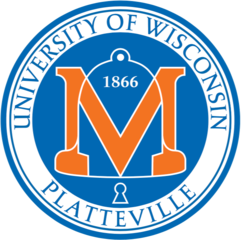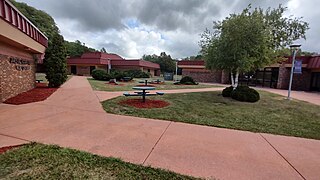
The Wisconsin Intercollegiate Athletic Conference (WIAC) is a college athletic conference that competes in the NCAA's Division III. In women's gymnastics, it competes alongside Division I and II members, as the NCAA sponsors a single championship event open to members of all NCAA divisions. As the name implies, member teams are located in the state of Wisconsin, although there are three associate members from Minnesota and one from Illinois. All full members are part of the University of Wisconsin System.

The University of Wisconsin–Parkside is a public university in Somers, Wisconsin. It is part of the University of Wisconsin System and has 4,644 students, 161 full-time faculty, and 89 lecturers and part-time faculty. The university offers 33 undergraduate majors and 11 master's degrees in 22 academic departments. UW-Parkside is one of two universities in the UW System not named for the city in which it is located, the other being UW-Stout. It is accredited by the Higher Learning Commission.

The University of Wisconsin–Superior is a public liberal arts university in Superior, Wisconsin. UW–Superior grants associate, bachelor's, master's and specialist's degrees. The university enrolls 2,559 undergraduates and 364 graduate students.

The University of Wisconsin–Milwaukee is a public urban research university in Milwaukee, Wisconsin. It is the largest university in the Milwaukee metropolitan area and a member of the University of Wisconsin System. It is also one of the two doctoral degree-granting research universities and the second largest university in Wisconsin.
The Wisconsin State University Conference (WSUC) was an American intercollegiate college athletic conference that was formed in July 1913 as the Wisconsin State Normal Conference. All member institutions were located in the State of Wisconsin. The WSUC sponsored competitions and championships in basketball, football, and other sports.

The Wisconsin Idea is a public philosophy that has influenced policy and ideals in the U.S. state of Wisconsin's education system and politics. In education, emphasis is often placed on how the Idea articulates education's role for Wisconsin's government and inhabitants. In politics, the Idea is most associated with the historic political upheaval and subsequent reformation during the Progressive Era in the United States.

University of Wisconsin–Platteville is a public university in Platteville, Wisconsin. Part of the University of Wisconsin System, it offers bachelor's and master's degrees. The university has three colleges that serve over 8,000 students on-campus and an additional 3,000 students through its five distance education programs.
The University of Wisconsin Colleges, established in 1971 was a unit of the University of Wisconsin System composed of 13 local two-year campuses and one online campus, University of Wisconsin Colleges Online. These campuses offered a liberal arts, transfer-parallel curriculum. The Colleges as a functional unit was dissolved as of June 30, 2018. The physical campuses are now affiliated with some of the four-year campuses of the University of Wisconsin System.
The University of Wisconsin–Extension (UW–Extension) was the outreach arm of the University of Wisconsin System. It provided statewide access to university system's resources and research to Wisconsin residents of all ages. Fulfilling the promise of the Wisconsin Idea, UW–Extension extended the boundaries of the university to the boundaries of the state through its four divisions of Cooperative Extension, Continuing and Online Education, Business and Entrepreneurship, and Public Broadcasting. It was created as a division of UW–Madison in 1907, and took its new form in 1965 as an autonomous unit. The abolition of UW-Extension as a separate entity was begun July 1, 2018.

The University of Wisconsin–La Crosse is a public university in La Crosse, Wisconsin. Established in 1909, it is part of the University of Wisconsin System and offers bachelor's, master's, and doctoral degrees. With 9,600 undergraduate and 1,000 graduate students, UW-La Crosse is composed of four schools and colleges offering 102 undergraduate programs, 31 graduate programs, and 2 doctoral programs. UW-La Crosse has over 95,000 alumni across all 50 U.S. states and 57 countries as of 2021.

The University of Wisconsin–Platteville Richland was a two-year campus of the University of Wisconsin System located in Richland Center, Wisconsin, United States. The college was a satellite campus of the University of Wisconsin–Platteville. The college's last semester ended in May of 2023.
Wisconsin State College of Milwaukee was a predecessor institution of the University of Wisconsin–Milwaukee.
The history of the University of Wisconsin–Milwaukee dates back to 1885, when the Milwaukee State Normal School opened for classes at 18th and Wells in downtown Milwaukee.
University of Wisconsin may refer to:
The University of Wisconsin–Milwaukee School of Education is an academic division of the University of Wisconsin–Milwaukee. It offers five undergraduate major, five master's, and 12 doctoral programs. It also offers the only four-year interpreter training degree in Wisconsin.

The University of Wisconsin–Milwaukee at Waukesha is a two-year college located in Waukesha, in the U.S. state of Wisconsin. A branch campus of the University of Wisconsin-Milwaukee, it is part of the University of Wisconsin System. Like the other 2-year UW campuses, UWM at Waukesha's land and buildings belong to a local government unit, in this case Waukesha County. As part of the local-state partnership, the University of Wisconsin provides faculty, staff, educational programs, technology, furnishings, libraries, and supplies. In 2018, the college became a regional campus of the University of Wisconsin-Milwaukee. The campus will close in spring 2025.

The University of Wisconsin–Platteville Baraboo Sauk County is a two-year branch campus of the University of Wisconsin–Platteville, located in Baraboo, Wisconsin. Founded in 1968, it was known as University of Wisconsin–Baraboo/Sauk County and was a part of the University of Wisconsin Colleges. It joined UW-Platteville in 2018 as a branch campus following dissolution of the UW-Colleges program. The University offers 5 associate degrees and 1 bachelor's degree.
College football at the University of Wisconsin–Milwaukee traces its lineage back to 1899. The original varsity program was terminated following the 1974 season. Club football was introduced at Milwaukee in 2003.

The Bachelor of Science in Sustainable Management is an online interdisciplinary sustainable management bachelor's degree program. A joint effort between the University of Wisconsin–Extension and four of the University of Wisconsin campuses, UW–Parkside, UW–River Falls, UW–Stout, and UW–Superior, the program began enrolling students for the fall 2009 semester.








































